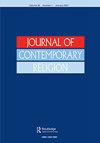东亚佛教在南非的发展轨迹:一个比较的视角
IF 0.6
3区 哲学
0 RELIGION
引用次数: 1
摘要
摘要在这篇文章中,我从米歇尔·克拉斯昆·约翰逊对南非主流佛教发展的六个主要主题(世俗实践、性别平等、对民主原则的坚持、西方心理学的影响、社会参与、非宗派传统的创造)的思考中得到启示,来探索东亚佛教在该国的三种形式:Dharma Centre(Korean Sŏn)-南非主流佛教的代表,以及两个大型新宗教运动的当地分支——日本的Soka Gakkai International(尼日莲佛教)和台湾的佛光山(中国净地/禅)——其中包括南非人口中更为多样化的部分。除了对该国东亚佛教的这些形式进行详细分析外,我还检验了Clasquin Johnson主题在个案研究中的适用性,并探讨了南非佛教比较研究的四个进一步主题:与当地宗教的互动、传教、杂交、世俗利益的承诺。本文章由计算机程序翻译,如有差异,请以英文原文为准。
Trajectories of East Asian Buddhism in South Africa: a comparative perspective
ABSTRACT In this article I take my cue from Michel Clasquin-Johnson’s reflections on six main themes (lay practice, gender equality, adhesion to democratic principles, impact of Western psychology, social engagement, creation of a non-sectarian tradition) underlying the development of mainstream South African Buddhism to explore three forms of East Asian Buddhism operating in the country: the Dharma Centre (Korean Sŏn)—a representative of mainstream South African Buddhism—and the local branches of two large new religious movements—the Japan-based Soka Gakkai International (Nichiren Buddhism) and the Taiwan-based Foguangshan (Chinese Pure Land/Chan Buddhism)—which include a more diverse section of the South African population. Besides providing a detailed analysis of these forms of East Asian Buddhism in the country, I test the applicability of Clasquin-Johnson’s themes to the case studies and explore four further topics for the comparative study of South African Buddhism: interactions with local religions, proselytization, hybridization, the promise of worldly benefits.
求助全文
通过发布文献求助,成功后即可免费获取论文全文。
去求助
来源期刊

Journal of Contemporary Religion
RELIGION-
CiteScore
1.20
自引率
0.00%
发文量
59
期刊介绍:
Journal of Contemporary Religion is an international peer reviewed journal. Its purpose is to both document and evaluate the anthropological, sociological, psychological, and philosophical aspects of emerging manifestations of religiosity in any part of the world—whether within innovative movements or mainstream institutions. The term ''religion'' in the title of this journal is understood to include contributions on spirituality. Moreover, as the journal title suggests, the focus is on contemporary issues. Therefore, the editors of Journal of Contemporary Religion welcome submissions which deal with: classical topics in the study of religion, such as secularisation and the vitality of religion or traditional sectarian movements; more recent developments in the study of religion, including religion and social problems, religion and the environment, religion and education, the transmission of religion, the materialisation and visualisation of religion in various forms, new forms of religious pluralism, the rise of new forms of religion and spirituality, religion and the Internet, religion and science, religion and globalisation, religion and the economy, etc. theoretical approaches to the study of religion; discussions of methods in relation to empirical research; qualitative and quantitative research and related issues. The Journal includes reviews of books which reflect the above themes.
 求助内容:
求助内容: 应助结果提醒方式:
应助结果提醒方式:


